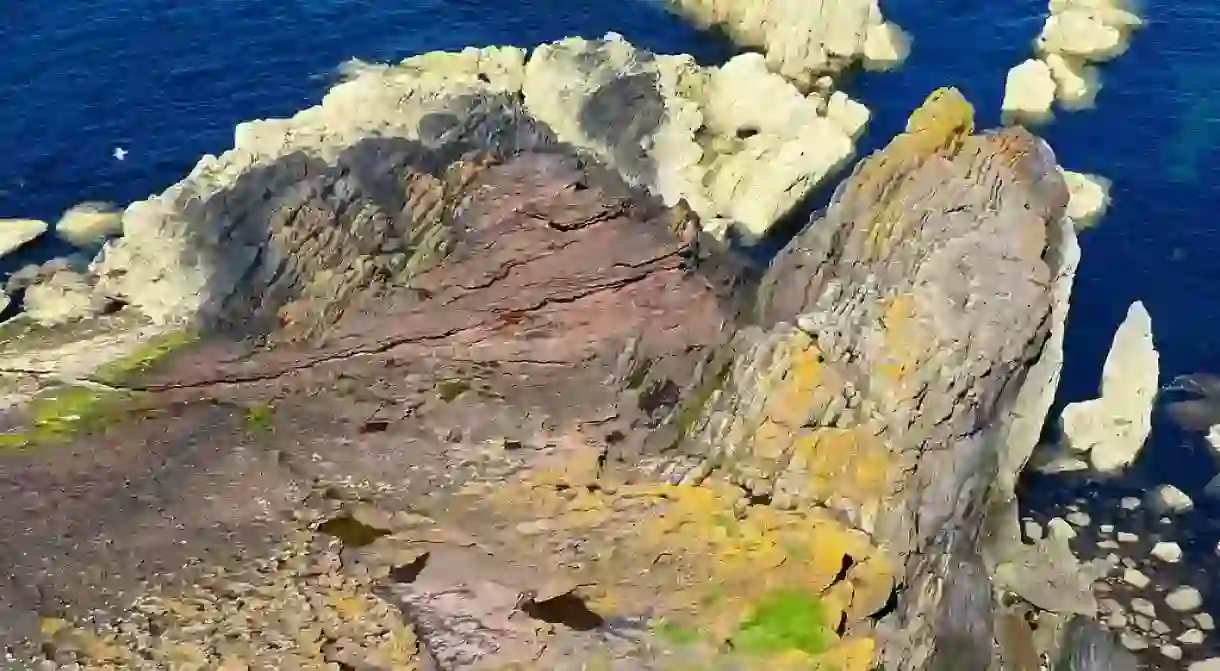This Scottish Cliff Is One Of The World's Most Important Geological Sites

Found off the beaten path just an hour’s drive from Edinburgh sits one of the most important geological sites in the world. Siccar Point, a dramatic rocky promontory framed by vivacious swelling sea, is the smoking gun that spurred Scottish Enlightenment thinker James Hutton to essentially rewrite the history of the Earth, as well as change the course of science and geologic time.
Emerging out of the North Sea near the picturesque village of Cockburnspath in the Scottish Borders, Siccar Point is a true hidden gem. Not only is it a pilgrimage destination for geology fans but it also acts as a magnet for nature lovers and wanderers with a penchant for coastal walks and rugged coastlines. Long before this Instagram-friendly cliff became a place of great scientific significance, it hosted a dun or tiny hill fort belonging to ancient Britons on the lookout for enemy invasions.
In a quest to prove his theory of the Earth’s age, James Hutton or the ‘father of modern geology’ embarked upon a coastal boat voyage to Siccar Point in 1788. Needless to say, it was a trip that didn’t disappoint, as it was here that the concept of ‘deep time’ was born.
Like wrinkles and scars etched onto the skin, Hutton noted that the rocks at Siccar point illustrated Earth’s story. This compelling narrative existed in the junction between the two different rock types present — dark grey vertical sheets of ancient oceanic rock and younger reddish horizontal sandstone formed on land.

The contrast of these very rocks proved Hutton’s theory that the Earth was in actual fact, older than the 4,000 to 10,000-year Biblical timescale which formed the general consensus across much of 18th century society.
Instead, the oceanic greywacke rock formed around 435 million years ago, just as its layers evolved over time when the mud on the seabed hardened, tilted and lifted above the waves before it eroded. However, the second sandstone rock came about some 65 million years later when the rivers of a sub-tropical Scotland deposited desert sands onto the greywacke.

And so, this junction or ‘unconformity’ between the terrestrial and oceanic layers of rock revealed to Hutton that tens of millions of years (as opposed to mere centuries or decades) were needed for major changes to occur on the planet — think erosion, deposition, folding, faulting and uplift.
On the day of the big Siccar Point discovery, Hutton was accompanied by fellow Scottish Enlightenment philosopher and mathematician John Playfair, who famously remarked that: “The mind seemed to grow giddy by looking so far into the abyss of time.”

Through deciphering the Earth processes at Siccar Point, Hutton and his beloved Scottish cliff played a key role in developing the concept of ‘deep time’, the vast timescale under which geologic processes occur and change to help carve the Earth. This fundamental geological principle was then documented in his work Theory of the Earth: “We find no vestige of a beginning — no prospect of an end.”
Not only did Hutton’s findings help decode the Earth’s processes and change the concept of time but they also helped establish geology as a science in its own right.
Today, over two centuries on, the magnificent ocean-rimmed Siccar Point still towers with its wondrous junction, just as it did when Hutton nearly fell out the boat due to euphoria (or so we’re guessing) in 1788! After exploring Hutton’s Unconformity and soaking up the geologic greatness, be sure to make a day of it and swing by Cove Harbour at Cockburnspath. Avid adrenaline junkies may want to bring their boards and test out the gnarly Scottish waves at nearby Pease Bay.














